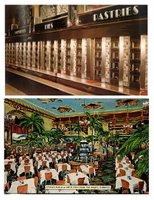 I first heard about the Antikythera Mechanism (pictured) when I went through my "UFO" phase in my early teens. I read about it in one of those books that try to explain away all the great achievements of early humans -- pyramids, Mayan structures, etc. -- by saying extraterrestrials did them.
I first heard about the Antikythera Mechanism (pictured) when I went through my "UFO" phase in my early teens. I read about it in one of those books that try to explain away all the great achievements of early humans -- pyramids, Mayan structures, etc. -- by saying extraterrestrials did them.It was really hard for me to put any stock in all those theories. Early human civilization was not just populated by grunting rock throwers. Such early civilizations created the screw mechanism, perspective in painting, early thoughts against the inherent wrong of slavery -- and other such heady stuff.
Not hard to believe was that some great mind, or assemblage of minds, created the earliest-known mechanism that is something like a computer: the Antikythera Mechanism.
New research, discussed in this New York Times article explains the probable uses of the mechanism: that of a method for determining the position of the moon and planets, possibly for use in the planting and harvesting of crops.
Although it is true another thousand years would pass before the next such mechanism would appear in the historical record, that does not in any way mean humans could not have created it.

